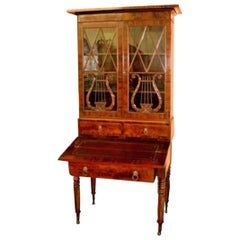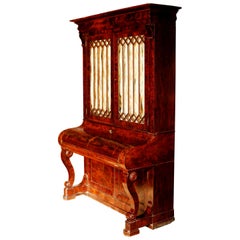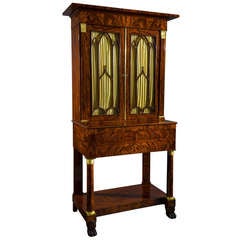Duncan Phyfe Secretary
Antique Early 19th Century American Neoclassical Bookcases
Mahogany
Recent Sales
Antique 1830s American American Classical Bookcases
Mahogany
Antique 19th Century American Neoclassical Bookcases
Pine, Poplar, Mahogany, Glass
Antique 19th Century American Secretaires
Mahogany, Poplar
People Also Browsed
Antique Late 19th Century Federal Bookcases
Leather, Glass, Mahogany
Antique 18th Century English George III Bookcases
Bronze
Vintage 1920s English George III Bookcases
Brass
Antique Early 1800s English George III Bookcases
Other
Early 20th Century American American Classical Sterling Silver
Sterling Silver
Antique Early 19th Century American Sheraton Secretaires
Mahogany
Antique Early 1900s American Art Nouveau Vases
Art Glass
Antique 19th Century English Chinese Chippendale Vitrines
Glass, Mahogany
Antique 1760s English George III Secretaires
Brass
Antique 19th Century American Beds and Bed Frames
Silk, Wood
Antique Early 19th Century English Hepplewhite Sideboards
Boxwood, Ebony, Mahogany, Satinwood
Antique Early 1800s American American Colonial Beds and Bed Frames
Mahogany, Satinwood
Antique 19th Century Italian Apothecary Cabinets
Glass, Walnut
Antique Late 19th Century English Bookcases
Glass, Walnut
Antique 19th Century American American Classical Beds and Bed Frames
Antique 18th Century English Georgian Sideboards
Brass
Finding the Right Storage-case-pieces for You
Of all the vintage storage cabinets and antique case pieces that have become popular in modern interiors over the years, dressers, credenzas and cabinets have long been home staples, perfect for routine storage or protection of personal items.
In the mid-19th century, cabinetmakers would mimic styles originating in the Louis XIV, Louis XV and Louis XVI eras for their dressers, bookshelves and other structures, and, later, simpler, streamlined wood designs allowed these “case pieces” or “case goods” — any furnishing that is unupholstered and has some semblance of a storage component — to blend into the background of any interior.
Mid-century modern furniture enthusiasts will cite the tall modular wall units crafted in teak and other sought-after woods of the era by the likes of George Nelson, Poul Cadovius and Finn Juhl. For these highly customizable furnishings, designers of the day delivered an alternative to big, heavy bookcases by considering the use of space — and, in particular, walls — in new and innovative ways. Mid-century modern credenzas, which, long and low, evolved from tables that were built as early as the 14th century in Italy, typically have no legs or very short legs and have grown in popularity as an alluring storage option over time.
Although the name immediately invokes images of clothing, dressers were initially created in Europe for a much different purpose. This furnishing was initially a flat-surfaced, low-profile side table equipped with a few drawers — a common fixture used to dress and prepare meats in English kitchens throughout the Tudor period. The drawers served as perfect utensil storage. It wasn’t until the design made its way to North America that it became enlarged and equipped with enough space to hold clothing and cosmetics. The very history of case pieces is a testament to their versatility and well-earned place in any room.
In the spirit of positioning your case goods center stage, decluttering can now be design-minded.
A contemporary case piece with open shelving and painted wood details can prove functional as a storage unit as easily as it can a room divider. Alternatively, apothecary cabinets are charming case goods similar in size to early dressers or commodes but with uniquely sized shelving and (often numerous) drawers.
Whether you’re seeking a playful sideboard that features colored glass and metal details, an antique Italian hand-carved storage cabinet or a glass-door vitrine to store and show off your collectibles, there are options for you on 1stDibs.
- 1stDibs ExpertMarch 22, 2022To know if your sofa is a Duncan Phyfe, start by examining the materials. Normally, Phyfe used solid mahogany wood. If you see any evidence of veneers or engineered wood, you likely have a reproduction. Also, look closely at the studs and nail-head trim. An original will have securely fastened hardware, and the hardware should appear naturally aged. Find a range of expertly vetted Duncan Phyfe sofas on 1stDibs.
- 1stDibs ExpertApril 5, 2022Duncan Phyfe furniture was founded in 1837. It was one of the first American cabinet-making companies to successfully use the factory method of manufacturing. Shop a collection of Duncan Phyfe furniture from some of the world’s top sellers on 1stDibs.
- 1stDibs ExpertAugust 17, 2021Duncan Phyfe tables can be worth anywhere between $50,000 and $150,000. To tell if your table is an original Duncan Phyfe, look for carved reeds, urn posts and pedestals, and lion-paw feet among others.
- 1stDibs ExpertOctober 24, 2024To tell if something is Duncan Phyfe, experts recommend consulting a certified appraiser or knowledgeable antique dealer. Although he produced many pieces between when he started his career in the 1790s and his retirement in the 1840s, Phyfe signed very few of his furnishings. What's more, there were hundreds of other furniture makers in his day who drew inspiration from his work and manufactured similar furniture. Reproductions of Phyfe pieces continue to this day, and the sheer volume of similar items can make identifying an original Duncan Phyfe extremely difficult without training and experience. Shop a variety of Duncan Phyfe furniture on 1stDibs.
- 1stDibs ExpertFebruary 22, 2021In an antique market today, an original Duncan Phyfe dining table would be worth between $50,000 to $150,000.


